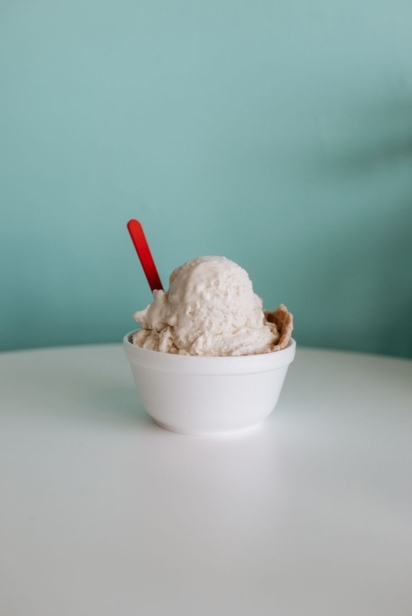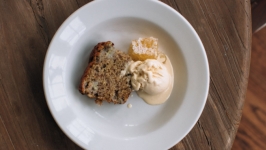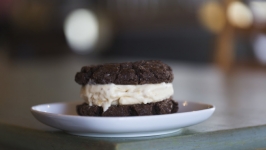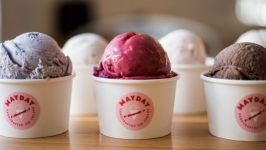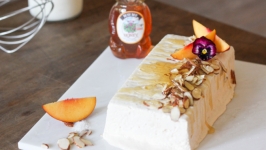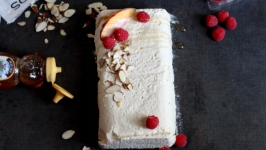The Scoop on Frozen Treats
I scream, you scream, we all scream (a lot) for ice cream. Recent data shows that about $11 billion worth of ice cream and frozen desserts are sold annually in the U.S., with the average American consuming more than 23 pounds of ice cream per year. Classic vanilla is the most popular choice, followed closely by chocolate, though there is a growing demand for exotic flavors such as matcha, ube and sesame.
Beyond flavor options, cooling down with a frozen treat is fraught with decision making. Do you want a cup or cone? Chocolate or rainbow sprinkles? And the most basic question to be answered: what to put in that cup or cone? Ice cream, soft serve, gelato, frozen custard, something else? What’s the difference, anyway?
Leave it to the government to define how we refer to those chilly treats. The Food and Drug Administration (FDA) has strict standards that determine what a frozen dessert can be called, based on the ingredients and how the product is manufactured. Here’s a guide to help you navigate the frozen tundra of treats.
ICE CREAM
Made from milk, cream or a combination of the two, this concoction must contain a minimum of 10% milkfat and 20% cream and must weigh no less than 4-½ pounds to the gallon, according to the FDA, in order to be called “ice cream.” While the process of making ice cream churns air into an ice cream base as it freezes to create a light mouthfeel, the weight requirement — known as “overrun” — establishes the amount of air that can be whipped into the product, thus preventing manufacturers from selling you too much air. Ice cream has to be less than 30% air. An ice cream base can be a pasteurized mixture consisting of one or more of a variety of dairy ingredients, including all types of milk: skim, condensed, evaporated, buttermilk and more, plus cream and “plastic cream,” also known as concentrated milk fat. The finished product should contain less than 1.4% egg yolk solids by weight of the food, exclusive of the weight of any flavoring ingredients.
Mayday Ice Cream: A full flight with house made sprinkles and galette: Straight up Strawberry, Toasted Coconut Dairy Free, Blood Orange Pineapple Sorbet, Strawberry Fields, Blue Sky Blues, Icebox Lemon
SOFT SERVE
The origins of soft serve are debated. Some sources attribute Tom Carvel, (the founder of Carvel Ice Cream stores), others the Dairy Queen family and one other story credits Margaret Thatcher, the former Prime Minister of England (in her role as a chemist at a food manufacturer). Wherever it came from, soft serve is made with 3 to 6% milkfat, (less than ice cream) and air content is ideally between 33 and 45% of the volume. Constantly churned to introduce more air, soft serve is frozen at a higher temperature than ice cream, leading to a softer, lighter texture – hence the name.
Soft serve is intended to be eaten right away, and is usually made at about 21 degrees, dispensed in a semi-firm state from the machine.
Bellwether: Avocado Lime and Toast Swirl with lime gummy bears, green edible glitter, sweetened bread crumbs and chocolate ganache
FROZEN CUSTARD
Frozen custard is thicker, smoother and creamier than ice cream, containing a minimum of 10% milkfat by weight. Frozen custard should also be at least 1.4% egg yolks by weight, making for a richer product than ice cream. A key difference between frozen custard and ice cream is the density of each product. Ice cream has plenty of air whipped into it to make it light and airy; frozen custard is slowly produced in a machine that minimizes the amount of air blended into the mixture. This results in a denser product. The typical serving temperature of frozen custard is 14 to 25 degrees, whereas ice cream is usually served at 5 to 10 degrees.
Whit's Frozen Custard: Mocha Almond Fudge
GELATO
The name means “frozen” in Italian, and while it is similar to ice cream, there are some significant differences. Ice cream typically contains more cream than milk, whereas gelato has 4 to 9% butterfat (lower than ice cream) and is made using more milk than cream. With only 20 to 30% air whipped into it (also less than ice cream), gelato is creamier, smoother and silkier. The churning process happens more slowly at a slightly higher temperature, making gelato denser than ice cream. The Italian treat is also served about 10 to 15 degrees, warmer than ice cream.
Some believe the flavors of gelato are more pronounced than ice cream, which may be due to the lower amount of butterfat and the temperature at which gelato is served. Lower butterfat means less of a coating on your tongue, so flavors have a more direct contact with your palate. Since gelato is served at a warmer temperature, your mouth and tongue are less numb and thus better able to taste the flavors.
Bambino Scoops: Grind Peanut Butter Gelato






